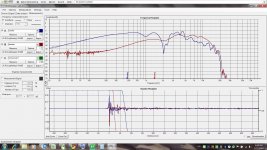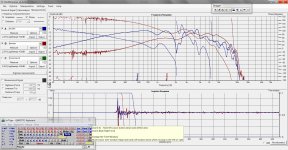hi,
I'm trying to measure my drivers with HolmImpulse. I am a beginner at this therefore I am not sure if I am measuring correctly. I have attached a picture of the results I received in the program.
The units I am using are:
Tweeter - Morel Supreme 110 (link below)
http://www.morelhifi.com/products/pdf/Tweeters/ST/Specs sheet ST1108.pdf
Woofer - MW267 (link below)
http://www.morelhifi.com/products/pdf/mw267.pdf
furthermore, I plan to stuff the cabinets with fiberglass. Currently the cabinets are empty. Will this matter in designing the crossover. My intuition says that I should put the crossover point around 1800 Hz. This is also compliant with my tests using Nuance to test different crossover points while listening to music rather than test signals.
Do these measurements make sense?
If so, how come the tweeter shows up softer than the woofer? The Tweeter is 91.5 decibels while the woofer is 88 dB (by specifications).
Also, after having all the measurements, what would be the next logical step? I'm trying to use speaker workshop, but it is proving to have quite a learning curve.
Thanks for the help,
Eitan Waks
I'm trying to measure my drivers with HolmImpulse. I am a beginner at this therefore I am not sure if I am measuring correctly. I have attached a picture of the results I received in the program.
The units I am using are:
Tweeter - Morel Supreme 110 (link below)
http://www.morelhifi.com/products/pdf/Tweeters/ST/Specs sheet ST1108.pdf
Woofer - MW267 (link below)
http://www.morelhifi.com/products/pdf/mw267.pdf
furthermore, I plan to stuff the cabinets with fiberglass. Currently the cabinets are empty. Will this matter in designing the crossover. My intuition says that I should put the crossover point around 1800 Hz. This is also compliant with my tests using Nuance to test different crossover points while listening to music rather than test signals.
Do these measurements make sense?
If so, how come the tweeter shows up softer than the woofer? The Tweeter is 91.5 decibels while the woofer is 88 dB (by specifications).
Also, after having all the measurements, what would be the next logical step? I'm trying to use speaker workshop, but it is proving to have quite a learning curve.
Thanks for the help,
Eitan Waks
Attachments
hi,
I'm trying to measure my drivers with HolmImpulse. I am a beginner at this therefore I am not sure if I am measuring correctly. I have attached a picture of the results I received in the program.
The units I am using are:
Tweeter - Morel Supreme 110 (link below)
http://www.morelhifi.com/products/pdf/Tweeters/ST/Specs sheet ST1108.pdf
Woofer - MW267 (link below)
http://www.morelhifi.com/products/pdf/mw267.pdf
furthermore, I plan to stuff the cabinets with fiberglass. Currently the cabinets are empty. Will this matter in designing the crossover. My intuition says that I should put the crossover point around 1800 Hz. This is also compliant with my tests using Nuance to test different crossover points while listening to music rather than test signals.
Do these measurements make sense?
If so, how come the tweeter shows up softer than the woofer? The Tweeter is 91.5 decibels while the woofer is 88 dB (by specifications).
Also, after having all the measurements, what would be the next logical step? I'm trying to use speaker workshop, but it is proving to have quite a learning curve.
Thanks for the help,
Eitan Waks
Greetings.
I would stuff the cabinet. Internal box resonances are going to add to the frequency response graph and confound what you are trying to test.
It looks like you have some room or floor bounce creating some issues with the woofer, but you can't tell until you stuff the box.
1800 Hz may be okay, but you are pushing it a little on the low side, but you can't help that with a 2-way.
What is the polarity relationship of the woofer and the tweeter?
Can you post a schematic of the crossover?
Last edited:
these measurements were taken for each driver independently. Currently there is no crossover installed.
I am attaching the schematic of the proposed crossover.
I am also attaching the polarity from the measurements.
Eitan Waks
I am attaching the schematic of the proposed crossover.
I am also attaching the polarity from the measurements.
Eitan Waks
Attachments
these measurements were taken for each driver independently. Currently there is no crossover installed.
I am attaching the schematic of the proposed crossover.
I am also attaching the polarity from the measurements.
Eitan Waks
1) Look at the net amplitude response (black line)! Reverse your polarity of the tweeter. That is why you have that huge notch in the net amplitude response right at the crossover point. Ideally that should be smooth or a slight bump. Part of the problem is also the phase mismatch (see #3).
2) You need off-axis plots for both drivers. I think 7.5° increments are recommended out to 45° each side of the driver. The idea is to match the crossover point for the woofer and tweeter where the two drivers have the best match in side dispersion.
3) You don't have your phase diagrams shown. Mixing a 1st order and a 3rd order crossover will have some phase mismatch. 3rd order filters produce a 270°*phase shift, first order has a 90° phase shift. Flipping the tweeter polarity will fix that.
Can you try a 2nd order for both drivers? This will keep the phase coherent if you flip the tweeter polarity and compromise on your slopes a little. It will also flatten out the tweeter's high end hill and reduce the effects of the woofer's cone break up.
There are better people than I to advise you on this further, but I think that the advice given so far will get you a little further on the right path. Read the X-Over Pro User Manual for more tips and dig up some information on the web on crossover design. You probably will find some conflicting information, so take the source of information in consideration and keep asking questions!
- Status
- This old topic is closed. If you want to reopen this topic, contact a moderator using the "Report Post" button.

